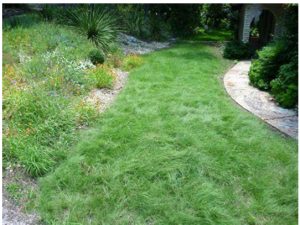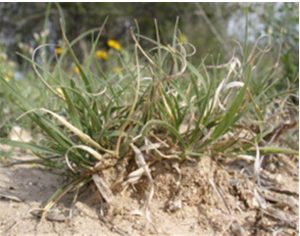By Debbie Roland and
Emmy Ulmschneider
Master Gardeners
Curly Mesquite (Hilaria Belanger) is a native, warm season grass that grows from Central Texas and Arizona south throughout Mexico. It is a grass, a monocot and not related to mesquite trees, which are dicots and members of the legume family. This grass is a perennial that forms stolons or runners which help it colonize dry soils ranging in texture from clay to gravelly. The genus name honors Augustin Saint-Hilaire an early French botanist who explored in South America, mainly in Brazil during the early 1800’s. He collected over 42,000 species of primarily plants, birds, and insects with some assorted reptiles, mammals and fish. When he returned to France, he spent the rest of his life describing classifying, and studying what he had collected. For his work, he was recognized as a knight in the French Legion of Honor.

The plant is pale green and grows in tufts, with new tufts developing at the nodes of the stolons. Stolons are modified stems growing above ground and are used for vegetative reproduction. This is one reasons why this grass can quickly colonize an area; think how quickly Bermuda grass can spread. The true stems are slender, up to a foot tall with short narrow leaves giving the plant a wavy texture. When the plant dries out and becomes dormant, the leaves curl up giving this plant its name.
Curly Mesquite is drought resistant, palatable to grazing animals when it is both green and when dry, thus is a valuable range grass for warm dry areas. It is one of the grasses used in range seeding mixes for central and west Texas. Along with Buffalograss, Buchloë dactyloides and Blue Grama, Bouteloua gracillis, Curly Mesquite is native grass with turf potential and so is a major species in readily available native lawn blends. It is also of use in controlling erosion on dry difficult areas. Native grasses also have ecological value, providing food, shelter, and protection for songbirds and beneficial insects across all the seasons. With their deep roots, they slow storm water runoff and return it to the soil and increase the fertility of the soil.

Plant Curly Mesquite during the spring in full sun as it will not tolerate shade. Growth begins in late spring. Thirty to forty days later the seedheads will emerge. Reproduction is primarily through stolons and propagation from seeds is difficult.
Try Curly Mesquite alone or with Buffalograss and Blue Grama as your turf grass of choice.
For more information, call the AgriLife office at 498-4071 in Odessa or at 686-4700 in Midland or visit aggie-horticulture.tamu.edu or westtexasgardening.org.




